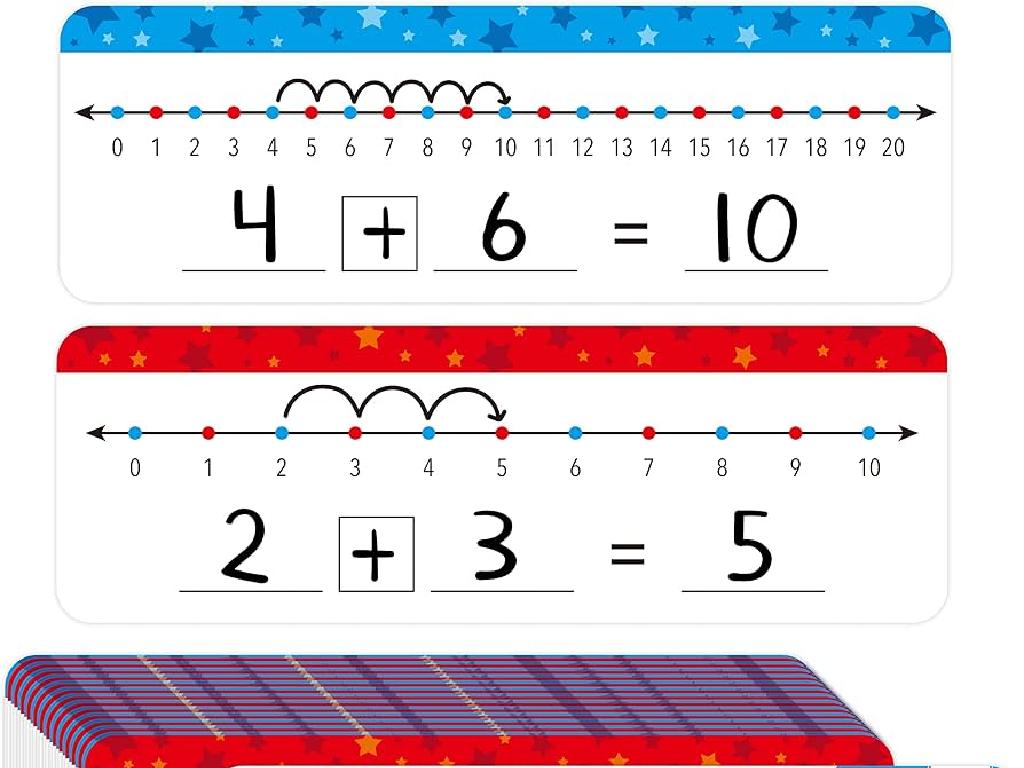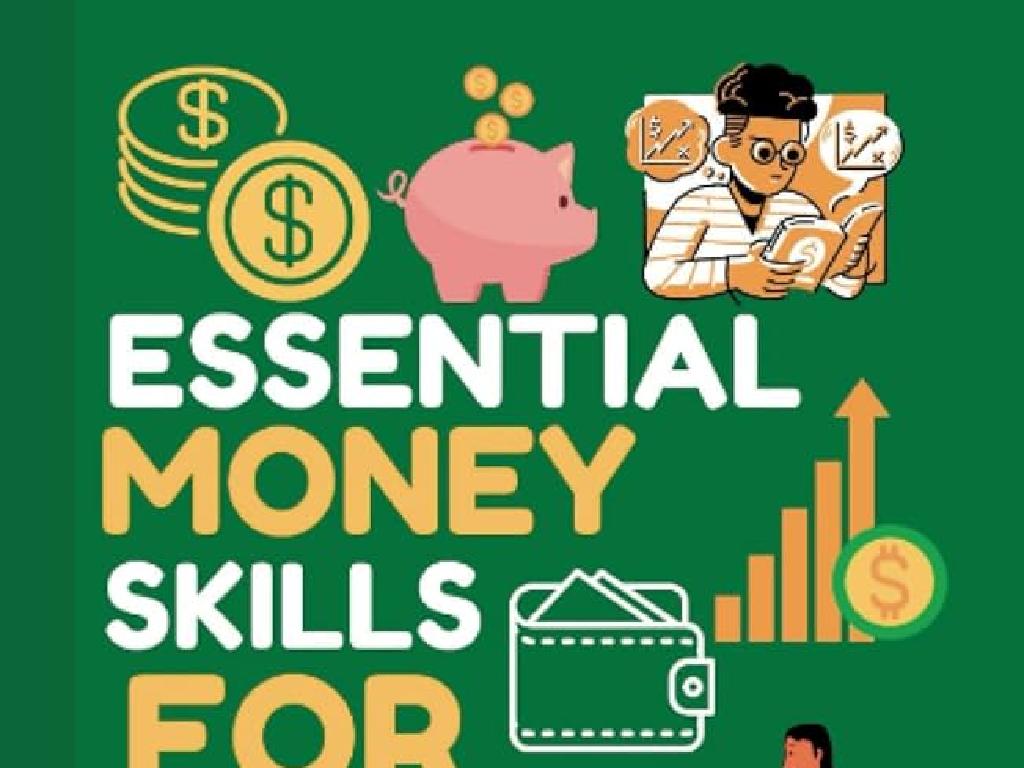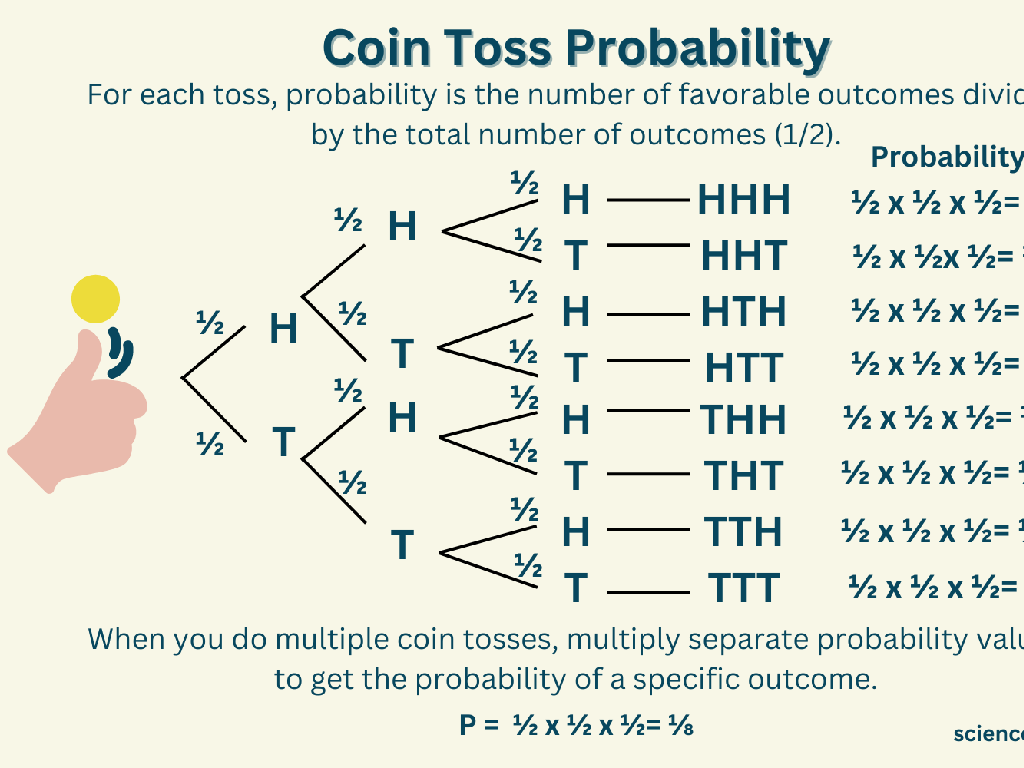Compare Money Amounts
Subject: Math
Grade: Fourth grade
Topic: Money
Please LOG IN to download the presentation. Access is available to registered users only.
View More Content
Introduction to Money: Understanding Value
– Learn about coins and bills
– Identify and value different coins and bills
– Discuss money’s role in daily life
– Money buys goods and services we need and want
– Review known money values
– Recall the values of pennies, nickels, dimes, and quarters
– Importance of comparing amounts
|
This slide introduces students to the concept of money, focusing on the physical forms of coins and bills and their respective values. Emphasize the practicality of money in everyday transactions, such as buying food or paying for a bus ride. Review the values of common coins and bills that the students are already familiar with to ensure a solid foundation for learning to compare different money amounts. Highlight the importance of being able to compare money when making purchases to ensure they are spending wisely and getting the correct change. Engage the students with examples and encourage them to share their own experiences with money.
Comparing Money Amounts
– Understanding money comparison
– To compare money means to evaluate which amount is larger or smaller.
– Comparing different amounts
– Look at two amounts and decide: which has more value, which has less?
– Using comparison symbols
– Learn symbols: > means greater, < means less, = means equal.
– Practice with real examples
– Use price tags, bills, and coins to apply what we've learned.
|
This slide introduces the concept of comparing money, a fundamental skill in financial literacy. Start by explaining that comparing money is just like comparing numbers; it involves evaluating to see which amount is larger or smaller. Use real-life examples such as price tags or different denominations of bills and coins to make the concept relatable. Introduce the mathematical symbols for greater than, less than, and equal to, and demonstrate how they are used to compare two amounts of money. Encourage the students to practice by setting up scenarios where they have to use these symbols to compare prices or money amounts. This will help solidify their understanding and prepare them for more complex financial comparisons in the future.
Comparing Money Amounts
– Comparing value of coin piles
– Which pile of coins has a higher total value?
– Comparing stacks of bills
– Look at different bills and decide which stack is worth more.
– Mixed coins and bills comparison
– Learn to add different coins and bills to find the total value.
– Determining total value
|
This slide aims to teach students how to compare different amounts of money, whether in coins, bills, or a mix of both. Start with simple examples, such as comparing piles of the same coins, then move on to bills. For mixed coins and bills, demonstrate how to sort and add values to find the total. Use real-life examples or play money to make the activity engaging. Encourage students to explain their thought process as they compare values. This will help them understand the concept of money’s worth and improve their counting and addition skills. Prepare to have students practice with hands-on activities, such as role-playing shopping scenarios or using interactive money games.
Comparing Money Amounts: Practice
– Interactive comparison activity
– Solve problems as a class
– We’ll work through problems together on the board
– Discuss comparison strategies
– How to use greater than, less than, or equal to with money
– Share tips for quick comparison
– Look for same coins, then compare remaining amounts
|
This slide is designed for an interactive class activity where students will engage in comparing different money amounts. Start by presenting a few problems that involve money comparisons and solve them together with the class, encouraging participation. Discuss various strategies such as lining up decimal points, comparing dollars first then cents, or looking for identical coins in each amount. Share tips like using greater than (>), less than (<), or equal to (=) symbols to compare money and how to quickly identify which amount is larger or smaller. Provide real-life examples such as comparing prices of items in a store to make the activity relatable. The goal is to build confidence in handling money and understanding its value.
Class Activity: Money Match-Up
– Match equal money amounts
– Work in pairs for the activity
– Share and explain your answers
– Discuss how you determined the matches
– Understand value equivalence
– Grasp that different coins can add up to the same amount
|
This activity is designed to help students understand the concept of value equivalence in money. Students will work in pairs to match different sets of coins and bills that add up to the same amount. This encourages collaboration and communication among students as they discuss and compare their findings. After the activity, each pair will share their answers with the class and explain the reasoning behind their matches. The teacher should prepare various sets of coins and bills for the activity, ensuring a mix of denominations. Possible variations of the activity could include matching prices of items, combining coins to reach a total amount, or even using play money to simulate purchasing items with a given budget.
Conclusion: Understanding Money Comparison
– Recap of money comparison
– Importance of comparing money
Helps with making smart buying choices and budgeting.
– Open floor for questions
– Reflect on today’s lesson
Think about how this skill can help you in real life.
|
As we wrap up today’s lesson, it’s crucial to revisit the key points about comparing money amounts. Emphasize to the students how this skill is applicable in everyday life, such as choosing between products in a store or saving up for something special. Highlight the importance of being able to make informed financial decisions, which is a valuable skill for their future. Open the floor for any questions the students might have, allowing them to clarify their doubts or expand their understanding. Encourage them to share any thoughts or insights they’ve gained from the lesson. This reflection helps to solidify their learning and recognize the practical application of the concepts taught.
Homework Challenge: Comparing Money
– Create money comparison problems
– Include a problem with coins
– Use pennies, nickels, dimes, and quarters
– Include a problem with bills
– Use $1, $5, $10, or $20 bills
– Include a problem with coins & bills
– Combine coins and bills in one problem
|
This homework task is designed to reinforce the concept of comparing different money amounts using coins and bills. Encourage students to be creative and come up with realistic scenarios for their problems, such as comparing prices of items or calculating change. Remind them to use a variety of denominations for coins and bills to create diverse problems. Provide examples to illustrate how to structure the problems. For instance, ‘If you have 3 dimes and 4 pennies, and your friend has 1 quarter, who has more money?’ Tomorrow, students will have the opportunity to present their problems to the class, enhancing their understanding of money comparison and their ability to explain their reasoning.





